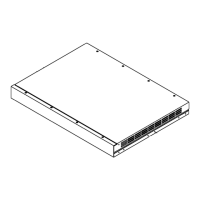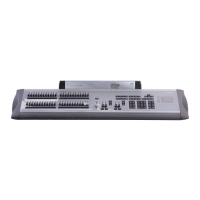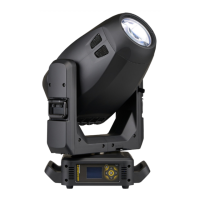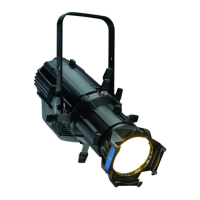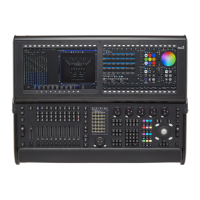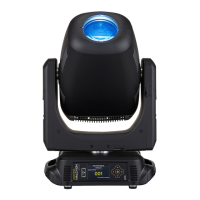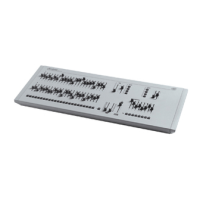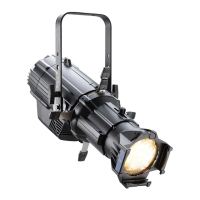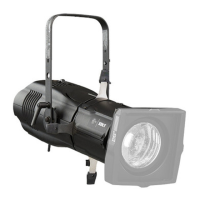Do you have a question about the ETC Express 72/144 and is the answer not in the manual?
Guides for initial system setup, referencing appendices and system settings.
Details HTP and LTP channel conventions for determining output levels.
Defines fixtures, fixture attributes, categories, and personalities for moving lights.
Details how to use the trackpad for setting rates and levels across different modes.
Explains the Stage display showing current levels of active channels up to 100.
Describes the Blind display for working on cues, groups, and submasters without affecting the live look.
Details the Fader display for isolating channels by A/B or C/D fader pairs and background faders.
Covers the Patch display for creating and modifying channel-to-dimmer assignments and fixture patching.
Details how to set the total number of dimmers in the system, considering port doubling and moving lights.
Explains how to reduce channel count to optimize processing time and free console memory.
Guides on changing default upfade and downfade times for cues.
Details setting the console's real-time clock and astronomical clock features.
Describes the default one-to-one patch assignment for dimmers to channels.
Explains how to create any dimmer-to-channel configuration, including groups of dimmers.
Describes dimmer profiles as variable levels sent to dimmers during fades to compensate for nonlinear characteristics.
Details how to raise unparked dimmers to a specified level on stage for checking, one at a time.
Explains how channel color and behavior depend on their modes like Selected, Captured, Recorded, Moving, and Tracked.
Details settings for every console channel, including Independent, Flip, 16-bit, LTP, and Label.
Details selecting channels using the keypad for setting levels, including single, consecutive, and excluded selections.
Guides on assigning output levels to channels using basic format, channel sliders, trackpad, Full key, Level key, and Flash.
Covers managing fixture personalities, including loading, viewing, deleting, and resetting them.
Explains how to install fixtures in the Fixture Patch display and edit the fixture list.
Details customizing attribute assignments to categories for referencing during programming.
Describes the Fixture Box window for setting attribute levels for moving lights.
Explains the console's Record and Track functions for saving channel states into cues, groups, or submasters.
Provides step-by-step instructions for recording cue 1 with specific channel levels and other attributes.
Details recording a cue in Blind mode, including how channel levels are indicated by color.
Explains recording cues with different upfade and downfade times.
Explains track record for new cues or modifying existing ones, maintaining channel levels across cues.
Explains the difference between Record and Track when modifying cues or inserting new ones.
Details how to make tracked channels track at a different level or use track record for new cue recording.
Details inserting a cue between recorded cues, allowing for decimal numbering.
Guides on recording cues with one or more parts, with a maximum of eight parts per cue.
Covers adding/deleting parts or channels, changing levels, or modifying fade/wait times within a multipart cue.
Details setting fade and wait times for parts to a multipart cue.
Explains various methods to determine which cue will play next, including keypad selection, Go key, macros, and subroutines.
Describes the console's two timed fader pairs (A/B and C/D) for playing back recorded cues.
Covers manual override and rate override for controlling cue playback fade levels and rates.
Allows running through cues without waiting for fades, snapping cues to completed levels instantly.
Illustrates creating groups using newly selected channels or from a look already on stage.
Details modifying previously recorded groups in Stage using the Update function, including restricting updates with Only.
Explains deleting groups from memory in Stage, Blind, or Fader displays.
Explains treating channels recorded in a cue or submaster as if they were in a group for stage display or recording.
Guides on creating focus points containing settings for attributes of several fixtures.
Explains using Solo to selectively record attribute settings for moving lights into focus points.
Details modifying focus points by adding/deleting fixtures or setting attribute levels.
Explains using focus points as level setting devices for fixtures and channels, and how recordings linked to focus points update automatically.
Describes different submaster types: Pile-on, Inhibitive, and Effect.
Guides on creating a simple pile-on submaster in Stage or Blind mode.
Explains modifying submasters in Blind mode, including editing channel numbers and levels.
Explains clearing contents of individual or all submasters using the Submaster List or Clear Functions menu.
Allows editing of cue attributes like upfade, downfade, wait times, link, follow, rate, and cue labels.
Allows editing of bump button status, fade times, type, rate, and label for submasters.
Shows recorded groups by number and label, allowing paging, labeling, and deletion.
Lists all focus points by number and label, allowing paging, labeling, and deletion.
Guides on parking dimmers by specifying number and level, and unparking them individually or all at once.
Explains parking channels by number and level, using the keyboard or focus points, and unparking them.
Covers parking fixtures at levels set from the keypad or at a focus point, and unparking them.
Details parking channels and fixtures at a focus point, linking them for automatic level updates.
Introduces the Blind Effects display for creating and editing effects, outlining its features like attributes, rates, and steps.
Details the procedure for creating an effect in Blind mode, including navigating the display and adding steps.
Explains building an effect in Stage while viewing results with captured channels, allowing addition of channels directly, in groups, or linked to focus points.
Guides on changing step timing and levels, including setting step time, in/dwell/out times, low/high levels.
Guides on creating subroutines in the Blind display, with up to 100 steps, and the process of defining cue or style steps.
Explains editing subroutines by selecting steps, using softkeys, and saving changes with Record Enter.
Details deleting steps from an effect, which causes subsequent steps to be renumbered.
Explains inserting a new step into an effect, which takes the place of the selected step and renumbers subsequent steps.
Covers creating macros in Macro Editing mode or using the console’s macro Learn mode to record keystrokes.
Explains how macros run, the LED indication, and playing macros via their keys or by number.
Details editing macros in Insert or Replace modes using editing keys and softkeys.
Explains clearing individual or all macros from the Macro display mode.
Describes the Link List display, showing channel assignments to trackpad axes (X/Y) for simultaneous control.
Guides on assigning channels to X and Y lists for trackpad control and setting the trackpad mode.
Explains removing a link from the Link List and renumbering subsequent links.
Details saving shows to diskettes for backup, transferring shows, and using more than 600 cues.
Provides instructions for formatting diskettes on the console or an IBM PC-compatible computer.
Guides on writing a showfile to diskette, including saving show and configuration information.
Explains reading show or system configuration contents from diskette, noting data overwrites.
Covers verifying printer installation and accessing Print Functions menu for various printouts.
Provides a general procedure for all printouts, using Print Stage Display as an example.
Lists all 17 print options and explains the content of each printout.
Explains erasing information for various console functions like Show, Cues, Groups, Submasters, etc.
Details the procedure for clearing and resetting functions, using Clear Show as an example.
Lists and explains the 14 options available on the Clear Functions menu for erasing data and resetting settings.
Guides on setting the console's operating mode to one scene or two scene, with different procedures for Express 24/48 and other models.
Explains how A/B faders control scenes in two scene mode, allowing manual crossfades.
Details creating scenes and running shows using manual crossfades by manipulating A/B faders.
Explains running timed crossfades between scenes using A/B fader controls and setting upfade/downfade times.
Guides accessing the ETCLink Functions menu for dimmer monitoring options.
Details enabling the console to work with the ETCLink network and handling error advisory messages.
Categorizes ETCLink messages into fatal and secondary, explaining their meaning and display.
Details monitoring individual dimmer loads for troubleshooting, using the Load Management display.
Introduces MIDI communication protocol and its support for MIDI Show Control (MSC) and ETC MIDI.
Lists MIDI message formats used for console control, including Note off, Note on, Control Change, Program Change, and Pitch Bend.
Explains recognized MSC commands (Go, Stop, Resume, Fire) and configuring MIDI Show Control.
Guides on creating and executing real-time programs based on time of day or astronomical events.
Provides step-by-step instructions for physically installing the console and its monitor.
Explains connecting dimmers to the console using DMX512 outputs and pinout specifications.
Covers configuring DMX512 ports, including setting starting dimmer numbers and DMX512 speed.
Guides on connecting an alphanumeric keyboard to a remote interface unit for assigning labels.
Discusses ETC's Remote Interface Unit (RIU) and Remote Video Interface (RVI) for remote network operations.
Details the DIP switch and jumper settings for the RIU's main circuit board for configuration.
Describes the RVI's ports for remote accessories, including monitor, keyboard, and RFU connections.
Explains connecting the console to a network using twisted pair or thinnet cables.
Lists common diskette errors like Bad Disk, Corrupted Disk, Disk Full, File Not Found, and No disk in drive.
Covers error messages like Out of memory, explaining their causes and potential resolutions.
Lists ETCLink errors, categorizing them into fatal and secondary messages.
Details configuration information included with show contents and where each item can be edited.
Identifies configuration information retrieved when reading show contents from disk.
Identifies configuration information retrieved when restoring system configuration from disk.
Lists softkey functions available within the Stage and Stage 2/3 displays.
Lists softkey functions available within the Blind/Cue and Cue 2/3 displays.
Lists softkey functions available within the Blind/Group and Group SS displays.
Lists softkey functions available within the Blind/Focus and Focus SS displays.
Provides a list of US cities with their standard time zones, latitude, and longitude.
Lists cities outside the US with their standard time zones, latitude, and longitude.
Outlines system capacities for cues, channels, dimmers, multipart cues, groups, focus points, macros, and submasters.
Describes loading fixture personalities, patching fixtures, attribute categories, fixture box level adjustment, and fixture focus with Solo.
Lists cue capabilities including count, fade times, linked sequences, effect cues, split wait times, link to cue/macro, multipart cues, and spreadsheet editing.
Provides dimensions and weight for Express 24/48, 48/96, and 72/144 models.
States the declaration of conformity by Electronic Theatre Controls, Europe Limited, regarding product standards.
Outlines the warranty terms, conditions, exclusions, and customer obligations for ETC products.
Details the terms and conditions that control orders, superseding prior agreements and requiring written modification.
Guides for initial system setup, referencing appendices and system settings.
Details HTP and LTP channel conventions for determining output levels.
Defines fixtures, fixture attributes, categories, and personalities for moving lights.
Details how to use the trackpad for setting rates and levels across different modes.
Explains the Stage display showing current levels of active channels up to 100.
Describes the Blind display for working on cues, groups, and submasters without affecting the live look.
Details the Fader display for isolating channels by A/B or C/D fader pairs and background faders.
Covers the Patch display for creating and modifying channel-to-dimmer assignments and fixture patching.
Details how to set the total number of dimmers in the system, considering port doubling and moving lights.
Explains how to reduce channel count to optimize processing time and free console memory.
Guides on changing default upfade and downfade times for cues.
Details setting the console's real-time clock and astronomical clock features.
Describes the default one-to-one patch assignment for dimmers to channels.
Explains how to create any dimmer-to-channel configuration, including groups of dimmers.
Describes dimmer profiles as variable levels sent to dimmers during fades to compensate for nonlinear characteristics.
Details how to raise unparked dimmers to a specified level on stage for checking, one at a time.
Explains how channel color and behavior depend on their modes like Selected, Captured, Recorded, Moving, and Tracked.
Details settings for every console channel, including Independent, Flip, 16-bit, LTP, and Label.
Details selecting channels using the keypad for setting levels, including single, consecutive, and excluded selections.
Guides on assigning output levels to channels using basic format, channel sliders, trackpad, Full key, Level key, and Flash.
Covers managing fixture personalities, including loading, viewing, deleting, and resetting them.
Explains how to install fixtures in the Fixture Patch display and edit the fixture list.
Details customizing attribute assignments to categories for referencing during programming.
Describes the Fixture Box window for setting attribute levels for moving lights.
Explains the console's Record and Track functions for saving channel states into cues, groups, or submasters.
Provides step-by-step instructions for recording cue 1 with specific channel levels and other attributes.
Details recording a cue in Blind mode, including how channel levels are indicated by color.
Explains recording cues with different upfade and downfade times.
Explains track record for new cues or modifying existing ones, maintaining channel levels across cues.
Explains the difference between Record and Track when modifying cues or inserting new ones.
Details how to make tracked channels track at a different level or use track record for new cue recording.
Details inserting a cue between recorded cues, allowing for decimal numbering.
Guides on recording cues with one or more parts, with a maximum of eight parts per cue.
Covers adding/deleting parts or channels, changing levels, or modifying fade/wait times within a multipart cue.
Details setting fade and wait times for parts to a multipart cue.
Explains various methods to determine which cue will play next, including keypad selection, Go key, macros, and subroutines.
Describes the console's two timed fader pairs (A/B and C/D) for playing back recorded cues.
Covers manual override and rate override for controlling cue playback fade levels and rates.
Allows running through cues without waiting for fades, snapping cues to completed levels instantly.
Illustrates creating groups using newly selected channels or from a look already on stage.
Details modifying previously recorded groups in Stage using the Update function, including restricting updates with Only.
Explains deleting groups from memory in Stage, Blind, or Fader displays.
Explains treating channels recorded in a cue or submaster as if they were in a group for stage display or recording.
Guides on creating focus points containing settings for attributes of several fixtures.
Explains using Solo to selectively record attribute settings for moving lights into focus points.
Details modifying focus points by adding/deleting fixtures or setting attribute levels.
Explains using focus points as level setting devices for fixtures and channels, and how recordings linked to focus points update automatically.
Describes different submaster types: Pile-on, Inhibitive, and Effect.
Guides on creating a simple pile-on submaster in Stage or Blind mode.
Explains modifying submasters in Blind mode, including editing channel numbers and levels.
Explains clearing contents of individual or all submasters using the Submaster List or Clear Functions menu.
Allows editing of cue attributes like upfade, downfade, wait times, link, follow, rate, and cue labels.
Allows editing of bump button status, fade times, type, rate, and label for submasters.
Shows recorded groups by number and label, allowing paging, labeling, and deletion.
Lists all focus points by number and label, allowing paging, labeling, and deletion.
Guides on parking dimmers by specifying number and level, and unparking them individually or all at once.
Explains parking channels by number and level, using the keyboard or focus points, and unparking them.
Covers parking fixtures at levels set from the keypad or at a focus point, and unparking them.
Details parking channels and fixtures at a focus point, linking them for automatic level updates.
Introduces the Blind Effects display for creating and editing effects, outlining its features like attributes, rates, and steps.
Details the procedure for creating an effect in Blind mode, including navigating the display and adding steps.
Explains building an effect in Stage while viewing results with captured channels, allowing addition of channels directly, in groups, or linked to focus points.
Guides on changing step timing and levels, including setting step time, in/dwell/out times, low/high levels.
Guides on creating subroutines in the Blind display, with up to 100 steps, and the process of defining cue or style steps.
Explains editing subroutines by selecting steps, using softkeys, and saving changes with Record Enter.
Details deleting steps from an effect, which causes subsequent steps to be renumbered.
Explains inserting a new step into an effect, which takes the place of the selected step and renumbers subsequent steps.
Covers creating macros in Macro Editing mode or using the console’s macro Learn mode to record keystrokes.
Explains how macros run, the LED indication, and playing macros via their keys or by number.
Details editing macros in Insert or Replace modes using editing keys and softkeys.
Explains clearing individual or all macros from the Macro display mode.
Describes the Link List display, showing channel assignments to trackpad axes (X/Y) for simultaneous control.
Guides on assigning channels to X and Y lists for trackpad control and setting the trackpad mode.
Explains removing a link from the Link List and renumbering subsequent links.
Details saving shows to diskettes for backup, transferring shows, and using more than 600 cues.
Provides instructions for formatting diskettes on the console or an IBM PC-compatible computer.
Guides on writing a showfile to diskette, including saving show and configuration information.
Explains reading show or system configuration contents from diskette, noting data overwrites.
Covers verifying printer installation and accessing Print Functions menu for various printouts.
Provides a general procedure for all printouts, using Print Stage Display as an example.
Lists all 17 print options and explains the content of each printout.
Explains erasing information for various console functions like Show, Cues, Groups, Submasters, etc.
Details the procedure for clearing and resetting functions, using Clear Show as an example.
Lists and explains the 14 options available on the Clear Functions menu for erasing data and resetting settings.
Guides on setting the console's operating mode to one scene or two scene, with different procedures for Express 24/48 and other models.
Explains how A/B faders control scenes in two scene mode, allowing manual crossfades.
Details creating scenes and running shows using manual crossfades by manipulating A/B faders.
Explains running timed crossfades between scenes using A/B fader controls and setting upfade/downfade times.
Guides accessing the ETCLink Functions menu for dimmer monitoring options.
Details enabling the console to work with the ETCLink network and handling error advisory messages.
Categorizes ETCLink messages into fatal and secondary, explaining their meaning and display.
Details monitoring individual dimmer loads for troubleshooting, using the Load Management display.
Introduces MIDI communication protocol and its support for MIDI Show Control (MSC) and ETC MIDI.
Lists MIDI message formats used for console control, including Note off, Note on, Control Change, Program Change, and Pitch Bend.
Explains recognized MSC commands (Go, Stop, Resume, Fire) and configuring MIDI Show Control.
Guides on creating and executing real-time programs based on time of day or astronomical events.
Provides step-by-step instructions for physically installing the console and its monitor.
Explains connecting dimmers to the console using DMX512 outputs and pinout specifications.
Covers configuring DMX512 ports, including setting starting dimmer numbers and DMX512 speed.
Guides on connecting an alphanumeric keyboard to a remote interface unit for assigning labels.
Discusses ETC's Remote Interface Unit (RIU) and Remote Video Interface (RVI) for remote network operations.
Details the DIP switch and jumper settings for the RIU's main circuit board for configuration.
Describes the RVI's ports for remote accessories, including monitor, keyboard, and RFU connections.
Explains connecting the console to a network using twisted pair or thinnet cables.
Lists common diskette errors like Bad Disk, Corrupted Disk, Disk Full, File Not Found, and No disk in drive.
Covers error messages like Out of memory, explaining their causes and potential resolutions.
Lists ETCLink errors, categorizing them into fatal and secondary messages.
Details configuration information included with show contents and where each item can be edited.
Identifies configuration information retrieved when reading show contents from disk.
Identifies configuration information retrieved when restoring system configuration from disk.
Lists softkey functions available within the Stage and Stage 2/3 displays.
Lists softkey functions available within the Blind/Cue and Cue 2/3 displays.
Lists softkey functions available within the Blind/Group and Group SS displays.
Lists softkey functions available within the Blind/Focus and Focus SS displays.
Provides a list of US cities with their standard time zones, latitude, and longitude.
Lists cities outside the US with their standard time zones, latitude, and longitude.
Outlines system capacities for cues, channels, dimmers, multipart cues, groups, focus points, macros, and submasters.
Describes loading fixture personalities, patching fixtures, attribute categories, fixture box level adjustment, and fixture focus with Solo.
Lists cue capabilities including count, fade times, linked sequences, effect cues, split wait times, link to cue/macro, multipart cues, and spreadsheet editing.
Provides dimensions and weight for Express 24/48, 48/96, and 72/144 models.
States the declaration of conformity by Electronic Theatre Controls, Europe Limited, regarding product standards.
Outlines the warranty terms, conditions, exclusions, and customer obligations for ETC products.
Details the terms and conditions that control orders, superseding prior agreements and requiring written modification.
| Type | Lighting Control Console |
|---|---|
| Channels | 72 or 144 |
| Control Protocol | DMX512 |
| Display | LCD |
| Power Supply | Internal |
| Submasters | 24 |
| Patch Capacity | 999 |
